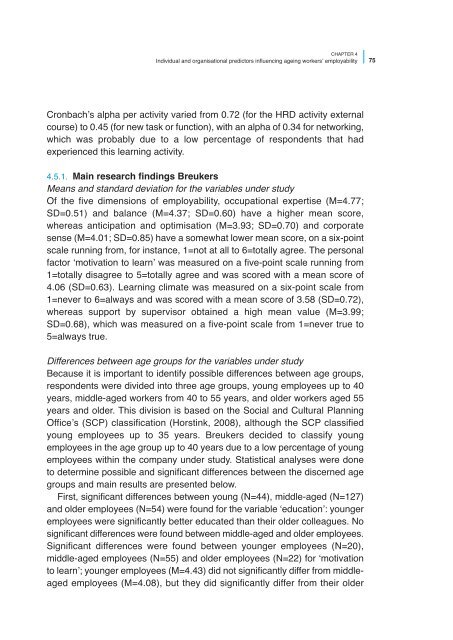Working and ageing - Cedefop - Europa
Working and ageing - Cedefop - Europa
Working and ageing - Cedefop - Europa
Create successful ePaper yourself
Turn your PDF publications into a flip-book with our unique Google optimized e-Paper software.
CHAPTER 4<br />
Individual <strong>and</strong> organisational predictors influencing <strong>ageing</strong> workersʼ employability 75<br />
Cronbachʼs alpha per activity varied from 0.72 (for the HRD activity external<br />
course) to 0.45 (for new task or function), with an alpha of 0.34 for networking,<br />
which was probably due to a low percentage of respondents that had<br />
experienced this learning activity.<br />
4.5.1. Main research findings Breukers<br />
Means <strong>and</strong> st<strong>and</strong>ard deviation for the variables under study<br />
Of the five dimensions of employability, occupational expertise (M=4.77;<br />
SD=0.51) <strong>and</strong> balance (M=4.37; SD=0.60) have a higher mean score,<br />
whereas anticipation <strong>and</strong> optimisation (M=3.93; SD=0.70) <strong>and</strong> corporate<br />
sense (M=4.01; SD=0.85) have a somewhat lower mean score, on a six-point<br />
scale running from, for instance, 1=not at all to 6=totally agree. The personal<br />
factor ʻmotivation to learnʼ was measured on a five-point scale running from<br />
1=totally disagree to 5=totally agree <strong>and</strong> was scored with a mean score of<br />
4.06 (SD=0.63). Learning climate was measured on a six-point scale from<br />
1=never to 6=always <strong>and</strong> was scored with a mean score of 3.58 (SD=0.72),<br />
whereas support by supervisor obtained a high mean value (M=3.99;<br />
SD=0.68), which was measured on a five-point scale from 1=never true to<br />
5=always true.<br />
Differences between age groups for the variables under study<br />
Because it is important to identify possible differences between age groups,<br />
respondents were divided into three age groups, young employees up to 40<br />
years, middle-aged workers from 40 to 55 years, <strong>and</strong> older workers aged 55<br />
years <strong>and</strong> older. This division is based on the Social <strong>and</strong> Cultural Planning<br />
Officeʼs (SCP) classification (Horstink, 2008), although the SCP classified<br />
young employees up to 35 years. Breukers decided to classify young<br />
employees in the age group up to 40 years due to a low percentage of young<br />
employees within the company under study. Statistical analyses were done<br />
to determine possible <strong>and</strong> significant differences between the discerned age<br />
groups <strong>and</strong> main results are presented below.<br />
First, significant differences between young (N=44), middle-aged (N=127)<br />
<strong>and</strong> older employees (N=54) were found for the variable ʻeducationʼ: younger<br />
employees were significantly better educated than their older colleagues. No<br />
significant differences were found between middle-aged <strong>and</strong> older employees.<br />
Significant differences were found between younger employees (N=20),<br />
middle-aged employees (N=55) <strong>and</strong> older employees (N=22) for ʻmotivation<br />
to learnʼ; younger employees (M=4.43) did not significantly differ from middleaged<br />
employees (M=4.08), but they did significantly differ from their older

















